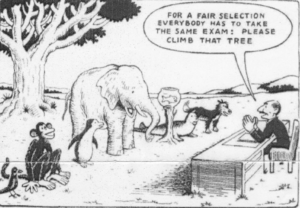You’ve signed up for that workshop you’ve wanted to take. It’s started. You’re in. You’re motivated. You want to feel included. You’re learning…well, sort of. Okay, not really.
Enter major roadblocks to your learning.
Here are some examples I’m sure you can relate to.
- When you’ve taken a workshop in the past, have you ever experienced any of the following?
- The content was too lecture-based.
- You felt pushed to take action/to implement your learning before you were ready.
- There was nothing to look at; no handouts, PowerPoint, images, flipcharts etc.
- There was nothing to do, nothing to act on; it was all theory.
- The instructor droned on and on.
- You felt like you needed to take care of the instructor (for example, they weren’t a subject matter expert, they had trouble with the technology or were flailing for some other reason).
- The power dynamics were off. For instance, one guy talked the whole time and the instructor did nothing.
- None of the examples included had anything to do with you. For example, the pictures of people the instructor used didn’t look anything like you.
All of the examples above are common ways to block learning and frustrate learners. They’re also ways to make learners feel left out and excluded.
It’s time to flip the learning, so access and inclusion issues are at the center.
I’ve written about these access and inclusion issues in the past (for example, The surprising reason workshops and webinars tend to suck, it is not what you think) but today we’re going to take a deeper dive.
Great learning is powerful learning and when we set out to create powerful learning, we must take note of the art and science of learning and development and how to not only make the learning materials inclusive and accessible but also the teaching.
Everybody
is a genius. But if you judge a fish by its ability to climb a tree, it will live its whole life believing it’s stupid. -Albert Einstein-

What’s accessible and inclusive for some isn’t for everyone. And when someone doesn’t feel included then not only do we block their learning, but we block the opportunity to learn from them, too. Everyone loses—individuals, organizations, and our communities.
It’s challenging to create inclusive and accessible learning but not impossible. In fact, to create workshops that are inclusive and accessible, we need to pay attention to these four critical steps. I’ll explain the first two here and the next two in next week’s post.
Designing and delivery learning

Let’s return to those eight examples of roadblocks to learning above. Which ones did you relate to the most? Every single time I talk about this issue, workshop participants bring up frustrating, vivid examples of the times they experienced roadblocks. Here are two truly true and horrible examples I experienced that have to do with pockets and pointing.
The first four examples are related to designing learning materials and the second set of four are related to delivering learning.
Notice that none of the examples have anything to do with the subject matter. Access and inclusion issues often have nothing to do with the actual content, but rather the roadblocks are related to design and delivery.
Therefore, the first step to ensure access and inclusion are at the center of learning is recognizing that subject matter expertise is only one part of the equation.
What’s a workshop designer to do? Put access and inclusion both at the center of design and delivery.
Structural and individual

The second step to designing accessible and inclusive workshops is paying attention to both individual and structural issues. I often see weary change-makers blaming themselves for not being able to effect social change. This increases significantly when working with communities that have experienced a lot of oppression. It is unfair and unjust to blame individuals for structural learning issues. I call it the “If only I work harder, I’ll make it” blues.
Our learners come in all sizes and shapes and all sorts of experiences with individual and structural issues, and challenges.
Weaving those issues into our design and delivery makes for better, more inclusive learning for everyone (instructors included). You’ll know your audience best and therefore which set of individual and structural issues to pay attention to but here are some examples:
• Literacy
• Gender
• Race
• Socio-economic
• Orientation to time, physical space etc.
• Sexual orientation
• Trauma (including ACEs – adverse childhood experiences)
• Overall power, privilege, and oppression issues (often related to the above)
The need to belong is powerful for all of us. The results of feeling included are many, including healthier, more diverse communities and organizations.
So now it’s your turn. Try your hand at using the two tools (design and delivery, and structural and individual) abovethe next time you’re creating a workshop.
Now go on and learn, laugh, and lead.
Learn

- Dig into what makes for powerful learning here by taking this quick survey
Laugh
- Wrestling over how to make your workshops accessible and inclusive? Take a breather and laugh over this very different type of wrestling.
Lead
- Act now. Use one of the two tools above when designing your next workshop. Your future participant will thank you.
P.S. Check out my ‘Workshops that Work’ online workshop so you can learn 4 steps to taking that beloved subject matter expertise of yours and start teaching it to others.
Lee-Anne Ragan, M.Ed., B.SW. is the learning and development expert behind the internationally award-winning Rock.Paper.Scissors, Inc., where great minds come to play. By combining humanity, humour, inclusion, and the capacity to see infinite possibilities, she takes people and organizations from gridlock to greatness — and everyone walks away with a smile on their face.
Her engaging training for corporate, non-profit, and academic organizations and incisive one to one work have made her indispensible to everyone from the United Nations to individual entrepreneurs. Original, adaptable and ever-inspiring as a trainer and teacher, her work has taken her to Africa, Asia, the Arctic, Mexico, from coast to coast in Canada, and to the United States.

